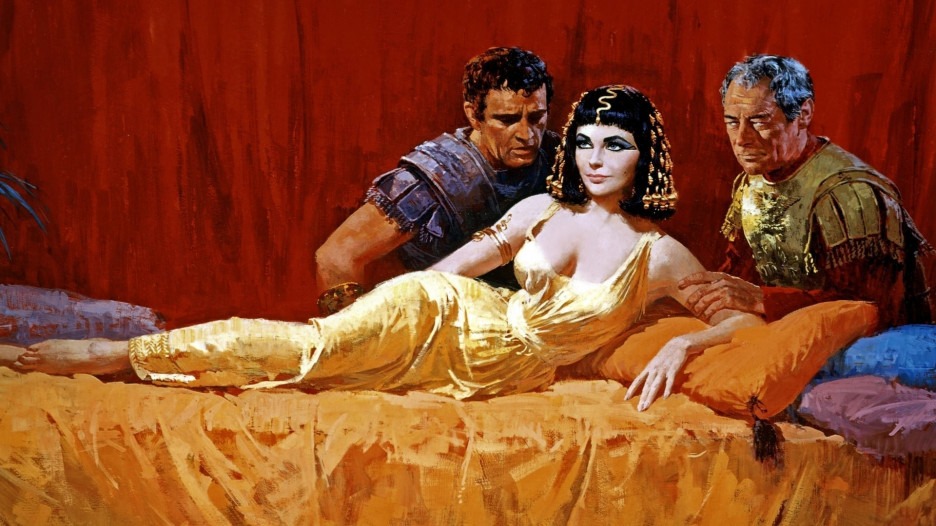Cleopatra (1963)

“Cleopatra,” directed by Joseph L. Mankiewicz and released in 1963, stands as one of the most ambitious and grandiose films in Hollywood history. With its extravagant budget, sprawling narrative, and star-studded cast, the film seeks to depict the life and times of the iconic Egyptian queen, Cleopatra VII. This essay explores the film’s portrayal of Cleopatra, its historical context, its production challenges, and its impact on cinema and popular culture.
“Cleopatra” dramatizes the life of Cleopatra VII, the last active ruler of the Ptolemaic Kingdom of Egypt. Her reign, which was marked by political intrigue, romance, and dramatic confrontations with the Roman Empire, provides a rich tapestry for cinematic exploration. The film delves into Cleopatra’s relationships with two of Rome’s most powerful leaders, Julius Caesar and Mark Antony, and her struggle to maintain her throne amidst the rising power of Rome.
The historical context of the film is crucial for understanding its narrative. The Ptolemaic dynasty, founded by Ptolemy I Soter after the death of Alexander the Great, had ruled Egypt for nearly three centuries by Cleopatra’s time. The film captures the geopolitical tension of the period, focusing on Cleopatra’s efforts to secure her position and protect her kingdom from the encroaching Roman Empire.

The plot of “Cleopatra” unfolds in three acts, each focusing on different phases of Cleopatra’s life and her relationships with Caesar and Antony. The film begins with Cleopatra’s initial meeting with Julius Caesar (played by Rex Harrison), portraying her as a shrewd and ambitious leader who uses her charm and political acumen to forge an alliance with the Roman general. Cleopatra’s entrance into Caesar’s court is marked by dramatic flair, highlighting her allure and political savvy.
The film’s second act centers on Cleopatra’s relationship with Mark Antony (played by Richard Burton), who becomes her lover and ally. The portrayal of Antony and Cleopatra’s romance is both passionate and tumultuous, reflecting the complex dynamics of their political and personal relationship. The film explores their joint efforts to resist the political machinations of Rome and their ultimate downfall.
The third act of the film focuses on the tragic end of Cleopatra’s reign. Following Antony’s defeat and suicide, Cleopatra’s attempts to negotiate with Octavian (later Augustus Caesar) lead to her ultimate demise. The film concludes with Cleopatra’s dramatic death, marking the end of an era for Egypt and the beginning of Roman dominance.

The casting of Elizabeth Taylor as Cleopatra is one of the most iconic aspects of the film. Taylor’s portrayal of Cleopatra is characterized by its grandeur and complexity. Her performance captures Cleopatra’s charisma, intelligence, and vulnerability, making her a memorable and compelling figure. Taylor’s role in the film earned her significant acclaim, and her opulent costumes and lavish makeup have become emblematic of the film’s portrayal of the queen.
Rex Harrison’s portrayal of Julius Caesar is marked by his authoritative presence and charm, capturing the complexity of Caesar’s character and his interactions with Cleopatra. Richard Burton’s performance as Mark Antony is equally notable, presenting Antony as a tragic figure whose love for Cleopatra and political ambitions lead to his downfall.

The production of “Cleopatra” was fraught with challenges, including budget overruns and delays. Initially, the film was budgeted at $2 million but ultimately cost around $44 million, making it one of the most expensive films ever made at the time. The production faced numerous issues, including changes in the cast, extensive reshoots, and lengthy delays, all of which contributed to its infamous reputation.
Despite these challenges, “Cleopatra” had a lasting impact on cinema. Its grand scale and opulent visuals set new standards for historical epics and influenced future films in the genre. The film’s use of elaborate sets, costumes, and special effects showcased the possibilities of cinematic spectacle and helped to define the epic genre for subsequent decades.
The film also contributed to the popularization of Cleopatra as a cultural icon. The image of Elizabeth Taylor as Cleopatra has endured in popular culture, influencing portrayals of the queen in various media. The film’s depiction of Cleopatra as a powerful and alluring figure has shaped the public’s perception of her historical legacy.

“Cleopatra” explores several themes, including power, ambition, and the intersection of personal and political relationships. The film portrays Cleopatra as a complex figure who uses her intellect and allure to navigate the treacherous political landscape of her time. Her relationships with Caesar and Antony highlight the interplay between personal desires and political strategy, illustrating the sacrifices she makes in her quest to maintain her throne and protect her kingdom.
The film also symbolizes the clash between the ancient Egyptian civilization and the rising power of Rome. Cleopatra’s struggle to maintain her rule represents the broader conflict between these two cultures, with her ultimate defeat marking the end of Egypt’s independence and the beginning of Roman dominance.
“Cleopatra” (1963) remains a monumental achievement in cinematic history, notable for its ambitious scope, lavish production, and iconic performances. The film’s portrayal of Cleopatra, coupled with its historical and cultural significance, offers a compelling narrative of power, love, and political intrigue. Despite the production challenges and its mixed critical reception, “Cleopatra” stands as a testament to the grandeur and complexity of historical epics, leaving a lasting legacy in the annals of film history.











